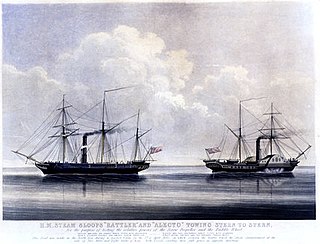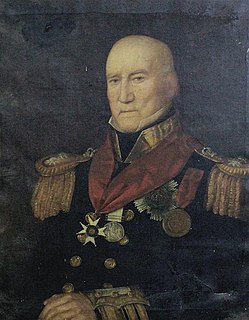
Kasuga Maru was a Japanese wooden paddle steamer warship of the Bakumatsu and early Meiji period, serving with the navy of Satsuma Domain, and later with the Imperial Japanese Navy. She was originally named Keangsoo, and was a wooden dispatch vessel built for the Imperial Chinese Navy. She was constructed in 1862 by Whites at Cowes, she formed part of the Lay-Osborn Flotilla during the Taiping Rebellion.

Sherard Osborn was a Royal Navy admiral and Arctic explorer.

Horatio Nelson Lay was a British diplomat, noted for his role in the ill-fated "Lay-Osborn Flotilla" during the Taiping Rebellion.

HMS Rattler was a 9-gun steam screw sloop of the Royal Navy, and one of the first British warships to be completed with screw propulsion. She was originally ordered as a paddle wheel 4-gun steam vessel from Sheerness Dockyard on 12 March 1841. She was reordered on 24 February 1842 as a propeller type 9-gun sloop from HM Royal Dockyard, Sheerness, as a new vessel. William Symonds had redesigned the ship as a screw propeller driven vessel.

HMS Pearl was a Pearl-class 21-gun screw corvette of the Royal Navy launched in 1855, displacing 2,187 tons.

The Algerine-class gunboats were a class of six 3-gun wooden gunboats built for the Royal Navy in 1857. A further pair were built in India for the Bombay Marine in 1859.

HMS Coromandel was a wooden paddle dispatch vessel of the Royal Navy. She was built for the P&O company as the passenger and cargo steamer Tartar. The Navy purchased her in 1855 and she participated in several battles in Chinese waters, including having been sunk and recovered. The Navy sold her in 1866 and she went through several changes in ownership before she was broken up in 1876.

The Rosario class was a class of seven screw-sloops of wooden construction built for the Royal Navy between 1860 and 1862. A further six vessels were ordered and laid down, but were cancelled in 1863 before launch. This was the last class of purely wooden sloops built for the Royal Navy.
Admiral Sir Henry Smith was a British officer in the Royal Navy. He commanded the Aden Expedition in 1839 which took Aden as the first colonial acquisition of the reign of Queen Victoria. For this service he was appointed a Companion of the Order of the Bath. Smith was then sent to serve on the China Station, where he fired the first shot of the First Opium War at the Battle of Kowloon. He played an important role at the controversial Battle of Chuenpi later in the year, and as senior naval officer on the south coast of China fought the Battle of the Barrier. He later participated in the Battles of Second Chuenpi, the Bogue, and Canton, before forming part of the Amoy garrison after the Battle of Amoy. Having left China in 1843, he went on to command ships in the Mediterranean and then in the Baltic Sea during the Crimean War. Smith never served at sea again after obtaining flag rank in 1855 but became superintendent of the Royal Hospital Haslar and the Royal Clarence Yard. He was appointed a Knight Commander of the Order of the Bath in 1873, retiring in the same year.

HMS Champion was one of nine Comus-class corvettes of the Royal Navy, built in the late 1870s and early 1880s to a design by Nathaniel Barnaby. Champion was one of three in the class built by J. Elder & Co., Govan, Scotland and was launched on 1 July 1878. She was the third vessel under this name in the Royal Navy.

The Albacore-class gunboat, also known as "Crimean gunboat", was a class of 98 gunboats built for the Royal Navy in 1855 and 1856 for use in the 1853-1856 Crimean War. The design of the class, by W. H. Walker, was approved on 18 April 1855. The first vessels were ordered the same day, and 48 were on order by July; a second batch, which included Surly, were ordered in early October.

HMS Volage was a sixth-rate sailing frigate launched in 1825 for the Royal Navy. At one point geologist Thomas Abel Brimage Spratt served aboard her.
HMS Mohawk was a British Vigilant-class gunvessel launched in 1856.
HMS Africa was a Victorian screw sloop launched in 1862 and sold to China later that year.
Tientsin was a British-made dispatch boat launched in 1863.
Kwangtung was a British-made dispatch boat launched in 1863.

Vice-Admiral Sir Charles Richardson was a Royal Navy officer of the eighteenth and nineteenth centuries. Richardson's naval career began when he joined HMS Vestal as a captain's servant in 1787. In Vestal he made an aborted journey to China before serving on the East Indies Station where he transferred to HMS Phoenix and fought in the Battle of Tellicherry and the Third Anglo-Mysore War in 1791 and 1792. Having returned to England as a master's mate, Richardson fought at the Glorious First of June on HMS Royal George in 1794 before being promoted to lieutenant in HMS Circe. In 1797 he successfully combated the Nore Mutiny in Circe before fighting in the Battle of Camperdown where he personally captured the Dutch admiral Jan Willem de Winter. Afterwards he became flag lieutenant to Admiral Adam Duncan and fought at the Battle of Callantsoog and the Vlieter Incident in the Anglo-Russian invasion of Holland of 1799. He then sailed to Egypt in HMS Kent where he again went onshore, fighting in the battles of Abukir, Mandora, and Alexandria in 1801.

HMS Seringapatam was a 46-gun Seringapatam-class fifth-rate frigate built for the Royal Navy between 1817 and 1821, the name ship of her class.
HMS Kestrel was a Clown-class gunboat of the Royal Navy. She was launched in 1856, serving in China and Japan in the 1850s and 1860s. She saw action during the Second Opium War and the Taiping Rebellion.
HMS Vesuvius was initially a Steam Vessel second class designed by Sir William Symonds, Surveyor of the Navy, and built at Sheerness. She was commissioned and participated in the bombardment of Acre in 1840, during the Russian War she was in the Black Sea and the Sea of Azov in 1855. Her last overseas posting was in the West Indies. She was sold for breaking in June 1865.













